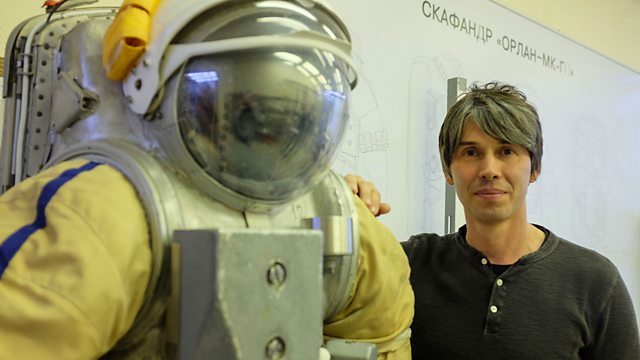Brian Cox’s Adventures in Space and Time episode 1: Brian believes we are at the start of a new age of space travel, where space flight is on the verge of becoming routine. In this episode, he explores the latest science and takes a new look at his old films and asks: how far can we go in our exploration of the cosmos?
Brian begins in Russia’s cosmonaut training facility in the outskirts of Moscow, where he dons a spacesuit to discover what ‘the right stuff’ is and what it might take to carry out maintenance on the International Space Station in low earth orbit. It is an eye-opening experience that reveals just how physically demanding being an astronaut can be.
He then looks at some of the most extraordinary achievements of space exploration to date. Under the clear sky of the Atlas Mountains, he tells the story of how we started to explore the cosmos from earth. Careful observation of ‘wandering stars’, now known as the planets, initially led our ancestors to believe that Earth, not the sun, was at the centre of our solar system. But as our knowledge of the cosmos grew, so did our appetite to explore; eventually technology made it possible for us to take our first steps towards the stars. In Russia’s Star City, Brian visits the office of Yuri Gagarin, the first man in space. At Cape Kennedy Space Centre he marvels at the enormous Saturn V rocket that launched the first men to the moon. Brian reflects on the difficulties of filming this giant machine, and on his encounters with the extraordinary men who flew in it to the moon.
Brian Cox’s Adventures in Space and Time episode 1 – Space: How Far Can We Go?
Looking to the future, Brian recalls his meeting with aerospace engineer and visionary advocate of Mars exploration Robert Zubrin. He’s credited with inspiring Elon Musk and Jeff Bezos to develop rockets with the aim of making the red planet the next frontier of human space exploration.
Professor Cox concludes that Mars will be the limit of human space exploration in our lifetime – our bodies can’t withstand the demands of travelling much deeper into the cosmos. To explore further, we must send robots in our place. Brian reveals some of his favourite probes to have uncovered the wonders of our solar system. This includes Voyager 1, whose iconic image of Earth from deep space taught us the true value of exploration: perspective.
Brian Cox
Cox studied physics at the University of Manchester during his music career. He earned a Bachelor of Science degree with first-class honours. After D:Ream disbanded in 1997, he completed his Doctor of Philosophy degree in high-energy particle physics at the University of Manchester. His thesis, Double Diffraction Dissociation at Large Momentum Transfer, was supervised by Robin Marshall and based on research he did on the H1 experiment at the Hadron Elektron Ring Anlage (HERA) particle accelerator at the DESY laboratory in Hamburg, Germany.
Everyone’s favourite softly-spoken physicist returns for this series looking back at his decade of science documentaries and pulling together some of their most breath-taking sequences to try and answer foundational questions like whether aliens exist, what gravity consists of and if we will ever be able to live in space. Presenting from the Royal Institution in London, Cox draws on material from hit BBC shows such as Wonders of the Universe, Forces of Nature and The Planets.





Pingback: Brian Cox's Adventures in Space and Time episode 2 — Are We Alone?